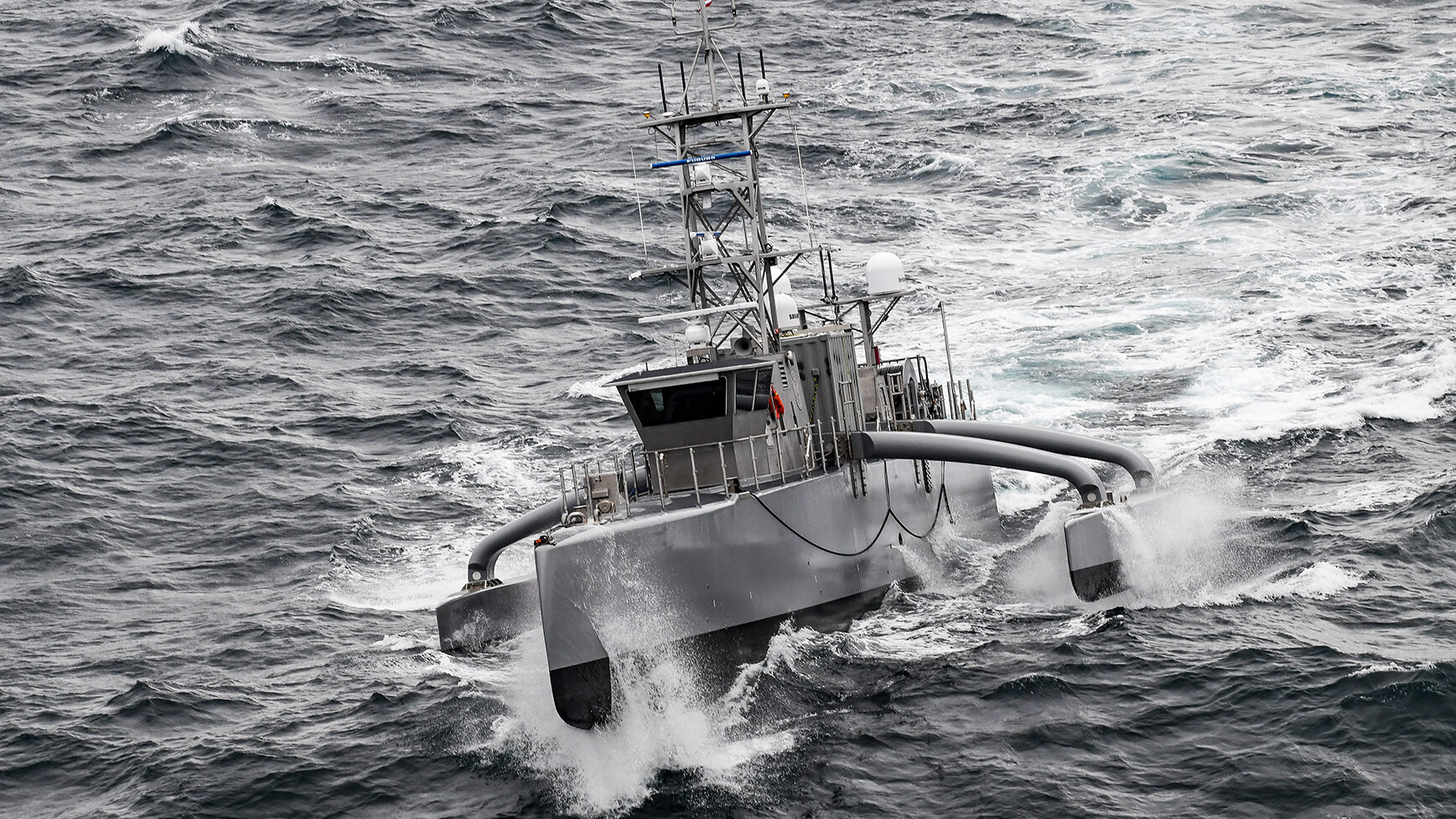
A Seahawk medium displacement unmanned surface vessel participates in U.S. Pacific Fleet’s Unmanned Systems Integrated Battle Problem (UxS IBP) 21, April 21. (U.S. Navy photo by Chief Mass Communication Specialist Shannon Renfroe)
WASHINGTON — After spending years experimenting with its Sea Hunter and Overlord programs, the US Navy is poised to take the “next step” in developing autonomous vessels: defining its own sets of standard interfaces so the service can pick and choose vendor tech as it sees fit.
The Navy has made “observations of which industry systems are doing better than others. And in some cases, it’s not just a [monolith],” Rear Adm. Casey Moton, the senior officer in charge of the efforts, told Breaking Defense in an exclusive interview this week. “System A does a better job with integrating sensors and identifying contacts… System B does a better job of collision avoidance.”
Although Moton declined to name specific vendors, he did say “several of the major manufacturers” for surface vessel autonomy have been included in the Navy’s research and development efforts. Now, the notes his team has taken and the feedback from exercises such as the Rim of the Pacific will play a key role as the Navy creates a “government-controlled autonomy baseline.” The “baseline” will effectively be a set of rules that companies must follow when developing capabilities for the service’s unmanned vessels to ensure compatibility.
RELATED: After RIMPAC, sailor feedback shows evolving view of unmanned vessels
That “next step” will materialize in the coming weeks — by the end of this calendar year — when Moton’s team publishes a formal solicitation to industry for a role dubbed the “autonomy baseline manager” (ABM), he said.
The ABM contract winner, scheduled to be announced in summer 2023, will assist the service in doing the ground-level engineering work required to continually integrate and update the wide variety of industry-developed “solutions” the Navy wants to use on any number of its future unmanned vessels.
“From an acquisition standpoint,” he said, the government-controlled baseline “allows us to continually inject competition.”
But Moton stressed that, unlike other acquisitions such as shipbuilding where prime contractors often put forward their own suggestions for sub-systems and other secondary decisions, the Navy intends to assert full control over the selected contractor.
“It’s simply a fact that in order to help integrate that government baseline, we need industry’s help,” he said, citing the volume of engineering work involved in managing and testing different systems. But “this ABM contractor is really executing the government’s bidding to develop the government autonomy baseline, which is composed of primarily industry-developed autonomy solutions.”
In the past, the service has defaulted to using whatever autonomy software was offered by a vehicle’s vendor. Moving forward, the Navy wants the ability to mix and match the best capabilities from individual companies.
To do that, both the individual capabilities the vehicle is employing — such as a sensor to detect potential obstacles — and the autonomy software that generates commands in response to incoming information must be built in such a way that they can interface.
If we “have company A’s LIDAR obstacle avoidance radar and we decide that we like company B’s LIDAR solution better,” said Moton, then “they are both pushing out a set of data that we have ensured are built to open standards so that we can relatively easily change out that sensor.”
It’s an ambitious goal, but not a new one for most in industry engaging with Moton’s team. For several years now, the program office for unmanned maritime systems has worked on this issue with various industry players in workshops centering on an initiative called the “Unmanned Maritime Autonomy Architecture.”
The acquisition strategy the Navy uses to go about soliciting and purchasing the rights to use different capabilities from various vendors is still a work in progress as part of the service’s bigger Large Unmanned Surface Vessel acquisition strategy development, said Moton.
“Nothing’s final, but what I don’t perceive as likely is what we’re often going to do in ship production where we are going to do a ship solicitation and have the machinery control system to some extent be selected by the shipbuilder,” he said. For unmanned autonomous programs, he said, “we are going to help define what that system is going to be.”
Major trends and takeaways from the Defense Department’s Unfunded Priority Lists
Mark Cancian and Chris Park of CSIS break down what is in this year’s unfunded priority lists and what they say about the state of the US military.


























